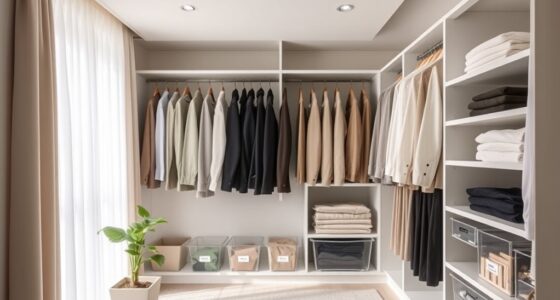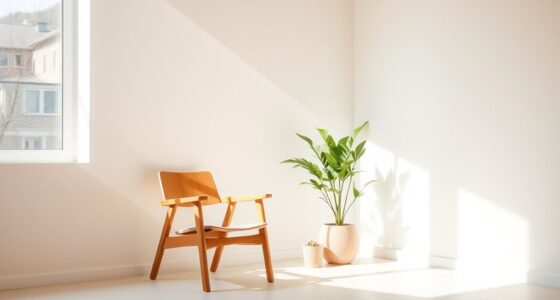When deciding what to keep, focus on what you truly need, use regularly, and love deeply. Emotional ties can make it hard to part with sentimental objects, but it’s important to balance feelings with practicality. Ask yourself if an item serves a current purpose or sparks joy. Developing a clear decision-making process helps you stay consistent and confident. Keep exploring strategies that support long-term organization and mindful choices to create a space that feels right for you.
Key Takeaways
- Assess if an item is currently useful, functionally in good condition, and enhances daily life or productivity.
- Determine if you genuinely love the item and it evokes positive feelings or meaningful memories.
- Consider how often you use the item and if it serves an ongoing purpose.
- Recognize emotional attachments but prioritize items that truly resonate or add value.
- Use a decision framework focusing on need, use, and love to make intentional decluttering choices.
Understanding Your Emotional Connection to Items
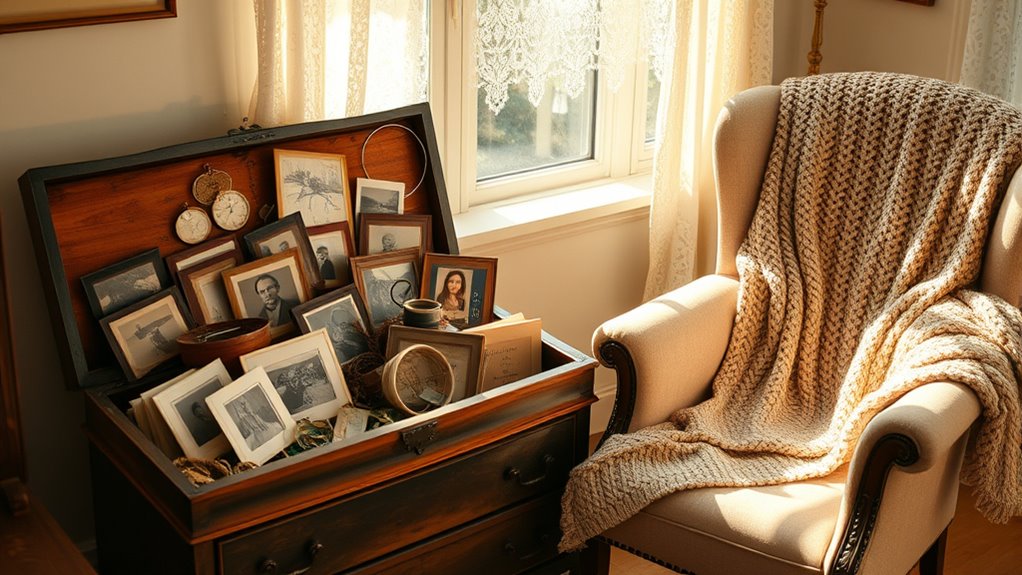
Have you ever wondered why letting go of certain possessions feels so difficult? It’s often because of the emotional ties you’ve developed with those items. Sentimental objects, like childhood toys or gifts from loved ones, hold memories and feelings that make parting with them feel like losing a piece of your past. These attachments create a psychological barrier, making decluttering feel like a loss rather than a gain. Your mind associates these possessions with important moments, leading to hesitation and resistance. Recognizing this emotional connection helps you understand why some items are harder to let go. By acknowledging these feelings, you can approach decluttering with compassion, balancing sentimental value with practical needs. Understanding the emotional connection to your possessions is an essential step toward making mindful decisions about what truly deserves a place in your life.
Assessing Practical Use and Functionality

After recognizing the emotional ties to your possessions, it’s important to evaluate their practical use and functionality. This step helps you determine if an item truly adds value to your life today. Consider these factors:
Assess if your possessions serve a current purpose, are functional, and enhance your daily life today.
- Does it serve a current purpose or meet a specific need?
- How often do you use or access the item?
- Is it in good condition and still functional?
- Does it improve your daily routine or productivity?
- Additionally, consider whether the item provides anti-aging effects or other benefits that enhance your well-being.
Recognizing the Value of Sentimental Items
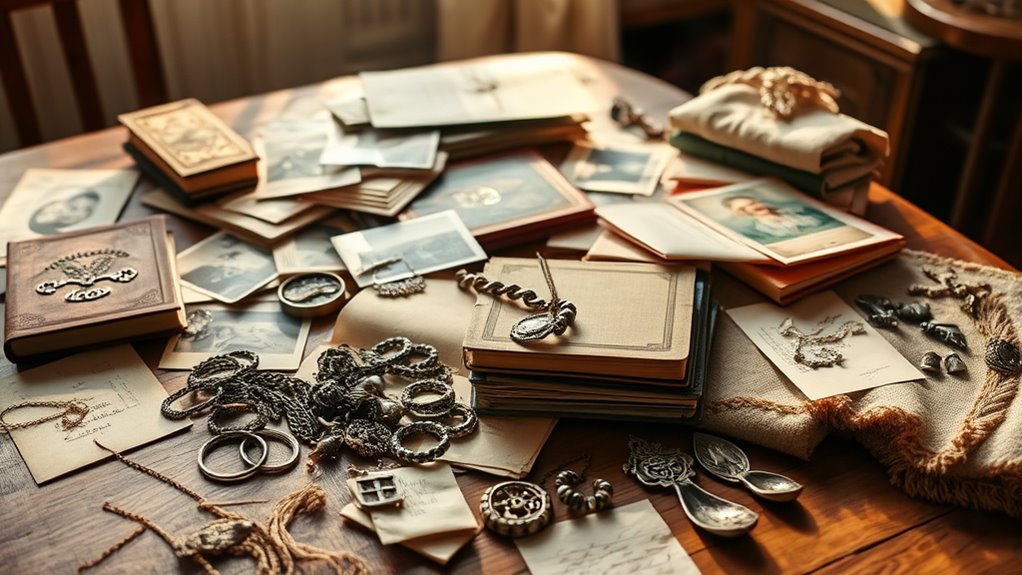
Recognizing the value of sentimental items requires understanding their emotional significance and the role they play in your life. These possessions often hold memories, milestones, or connections to loved ones, making them more than just objects. To evaluate their worth, ask yourself which items genuinely evoke positive feelings or meaningful memories, rather than acting as clutter reminders. Consider whether they serve a purpose beyond sentimentality, like sparking joy or inspiring reflection. Remember, emotional value isn’t about keeping everything that’s sentimental but about honoring what truly resonates with you. By recognizing what these items represent, you can make thoughtful decisions—preserving meaningful pieces while letting go of the ones that no longer serve a purpose in your current life. Understanding sentimental value can help guide your choices more intentionally.
Developing a Decision-Making Framework

To develop a solid decision-making framework, you need to start by clarifying your personal priorities so that your choices align with what’s most important. Next, set clear criteria to evaluate each item consistently, making decluttering less overwhelming. Additionally, understanding the transformative power of decluttering can motivate you to stay committed to your organizational goals. Finally, establish routines that keep your decisions steady over time, turning good habits into lasting organization.
Clarify Personal Priorities
Clarifying your personal priorities is essential for making effective decisions about what to keep and what to discard. Knowing what matters most guides your choices and prevents unnecessary clutter from taking over. To develop a clear framework, consider these four steps:
- Identify core values—determine what truly matters in your life, such as family, health, or growth.
- Set specific goals—define what you want to achieve with your space and possessions.
- Assess emotional significance—distinguish between sentimental value and emotional attachment that hinders progress.
- Prioritize functionality—focus on items that serve your current needs and support your objectives.
Additionally, understanding the importance of aquatic exercise can help you decide which water-related activities or equipment best align with your health goals.
Establish Decision Criteria
Developing clear decision criteria is essential for making consistent and confident choices about what to keep and discard during decluttering. You need specific standards to evaluate each item quickly and objectively, reducing hesitation and emotional attachment. Ask yourself whether the item is useful, aligns with your priorities, or brings genuine joy. Consider its frequency of use, sentimental value, and impact on your space. Set rules such as “keep only items used in the past year” or “hold onto items that serve a specific purpose.” These criteria help you avoid decision fatigue and stay focused. Establishing your benchmarks beforehand ensures your decluttering process remains efficient, purposeful, and aligned with your goals. Clear criteria empower you to make decisions confidently and maintain progress. Additionally, understanding the types of headphone jacks can help you determine whether your audio devices are compatible with current or future technology, streamlining your decision-making process when upgrading or replacing equipment.
Implement Consistent Routines
Establishing consistent routines is essential for making decluttering a sustainable habit. When you develop regular habits, decluttering becomes less overwhelming and more manageable. Consistency helps reinforce your decision criteria and reduces decision fatigue. To stay on track, consider these strategies:
- Schedule daily 10-minute tidying sessions to keep clutter in check.
- Create a weekly review to evaluate items you’ve kept or discarded.
- Set specific zones for decluttering to build focus and momentum.
- Use reminders or alarms to prompt routine activities and maintain accountability.
- Incorporate routine evaluation to adjust your habits as needed and ensure ongoing progress.
Overcoming Psychological Barriers to Decluttering

Why do so many people struggle to declutter despite knowing its benefits? Psychological barriers like emotional attachment, fear of regret, and decision fatigue block progress. These feelings create resistance, making it hard to let go of items that seem meaningful or necessary, even if they’re unused. To overcome this, recognize these mental blocks and challenge their validity. Here’s a quick guide:
| Barrier | Common Cause | How to Overcome |
|---|---|---|
| Emotional attachment | Sentimental value | Focus on memories, not stuff |
| Fear of regret | Losing something important | Practice decision-making gradually |
| Decision fatigue | Too many choices | Limit options, set time limits |
| Overwhelm | Clutter size | Break tasks into small steps |
| Psychological reactance | Resisting change | Reframe decluttering as self-care |
Strategies for Making Consistent Keep-or-Discard Choices

Making consistent keep-or-discard decisions can be challenging, especially when emotional attachments and decision fatigue interfere with clear judgment. To stay on track, try these strategies:
- Set clear criteria: Decide what makes an item worth keeping—usefulness, emotional value, or relevance—and stick to it.
- Create decision deadlines: Limit your time for each item to prevent overthinking and reduce fatigue.
- Use the “one in, one out” rule: For every new item, remove one similar item to maintain balance.
- Ask yourself key questions: Does this item serve a current purpose? Do I love it? Will I use it soon? If not, consider letting it go.
- Be mindful of emotional attachments and recognize how decision fatigue can cloud your judgment, making it harder to stay consistent.
Creating a Personalized Decluttering Routine

Have you ever wondered why some decluttering efforts stick while others fade fast? The key is creating a routine tailored to your habits and needs. Start by identifying when you’re most alert and least busy—perhaps mornings or evenings. Keep it simple: dedicate just 10 minutes daily or a specific day each week. Consistency beats intensity. Use a system that works for you, like grouping tasks by space or item type. Incorporating habit formation techniques can further reinforce your decluttering routines.
Maintaining Your Organized Space for Long-Term Success
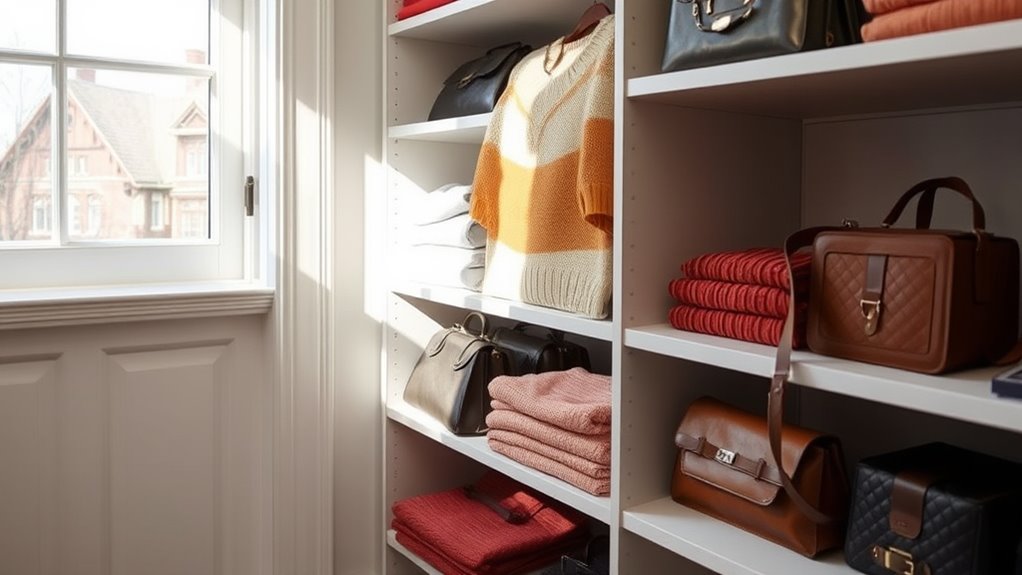
To keep your space organized long-term, you need to establish routine maintenance that fits your lifestyle. Setting clear decision roles helps prevent clutter from creeping back, and regularly reassessing your items keeps your space aligned with your current needs. Staying consistent with these steps guarantees your environment remains calm, functional, and clutter-free. Incorporating regular detoxification into your routine can further support a fresh and organized space by removing unnecessary items and promoting a healthier environment.
Establish Routine Maintenance
Establishing a routine maintenance plan is essential for preserving the benefits of your organized space over the long term. It keeps clutter from creeping back and ensures your environment stays functional and calming. To stay on track, consider these steps:
- Schedule daily 10-minute tidying sessions to maintain order.
- Set weekly review times to re-evaluate items and remove unnecessary clutter.
- Create a system for quick, ongoing decision-making to prevent accumulation.
- Designate specific spots for frequently used items to reduce search time.
Set Clear Decision Roles
How do you guarantee your decluttering efforts stick? By setting clear decision roles, you assign specific responsibilities for sorting, donating, or discarding items. This prevents indecision and reduces hesitation during decluttering sessions. You can designate roles like “Keep,” “Recycle,” or “Donate,” making choices straightforward and consistent. Clear roles also help you stay accountable and avoid reverting to cluttered habits. When everyone involved understands their responsibilities, the process becomes more efficient and less overwhelming. It minimizes confusion and keeps decision-making focused. Consistent roles reinforce your organizational system and make long-term maintenance easier. Ultimately, defining these roles helps embed decluttering into your routines, transforming a one-time effort into sustainable, long-lasting habits that keep your space organized.
Regularly Reassess Items
Regularly reevaluating your belongings is essential for maintaining an organized space over the long term. By periodically reviewing your items, you prevent clutter from creeping back and ensure your environment stays functional. Here are four key steps to stay on track:
- Set a schedule: Choose a recurring time—monthly or quarterly—to evaluate your possessions.
- Ask critical questions: Does this item serve a current purpose, bring joy, or hold sentimental value?
- Remove unnecessary items: Donate, recycle, or discard what no longer fits your needs or goals.
- Adjust storage solutions: Update organization systems as your belongings and routines evolve.
Consistent reassessment keeps clutter at bay and reinforces your commitment to an efficient, peaceful space.
Frequently Asked Questions
How Can I Handle Emotional Attachments Without Feeling Overwhelmed?
You can handle emotional attachments by setting small, manageable decluttering goals and giving yourself time to process feelings. Take photos of sentimental items before letting go, and focus on the memories rather than the objects. Practice self-compassion and remind yourself that decluttering creates space for new experiences. Enlist support from friends or family to stay motivated, and establish a routine that gradually reduces emotional overwhelm while honoring your feelings.
What Are Quick Ways to Assess an Item’s True Usefulness?
To quickly assess an item’s usefulness, ask yourself if it serves a current purpose or solves a problem. Check if you’ve used it in the past year, and consider if it aligns with your goals. If it’s broken, outdated, or rarely used, it’s probably not useful anymore. Trust your instincts—if it doesn’t add value or convenience, let it go to free up space and mental clarity.
How Do I Prioritize Sentimental Items Over Practical Ones?
Think of your sentimental items as treasures in a personal museum; they hold stories and emotions, while practical ones are tools for daily life. To prioritize, imagine your space as a stage—give each item a spotlight based on its story’s significance and frequency of use. Keep the exhibits that make your heart sing and serve your life, and gently let go of the ones that no longer play a meaningful role.
What Strategies Help Break Decision-Making Fatigue During Decluttering?
You can break decision-making fatigue during decluttering by setting a timer for short sessions, like 10-15 minutes, to prevent overwhelm. Focus on one area at a time, and categorize items into keep, donate, or discard. Take breaks often, and remind yourself that completing small steps boosts motivation. Simplifying choices reduces mental strain, making decluttering more manageable and less exhausting.
How Can I Stay Motivated to Maintain an Organized Space Long-Term?
You can stay motivated by recognizing that decluttering routines boost mental health, reducing stress hormone levels by up to 20%. Set small, achievable goals daily, like 10-minute tidy-ups, to build consistent habits. Celebrate your progress, and remember that maintaining an organized space enhances focus, saves time, and reduces anxiety. Visualize the peace and clarity you gain, making it easier to stay committed long-term.
Conclusion
By understanding your emotional ties, practical needs, and sentimental value, you build a solid foundation for decluttering. Remember, your belongings are like pages in your story—some deserve to be kept, others to be let go. With a clear framework and consistent routine, you’ll turn clutter into clarity. Keep moving forward; your organized space is a garden you tend, not a fortress to defend. Your best chapter is yet to come.



